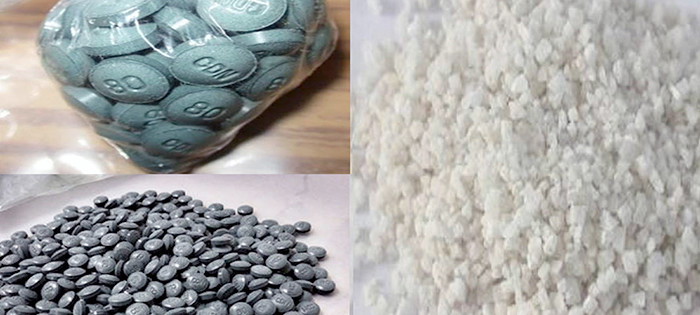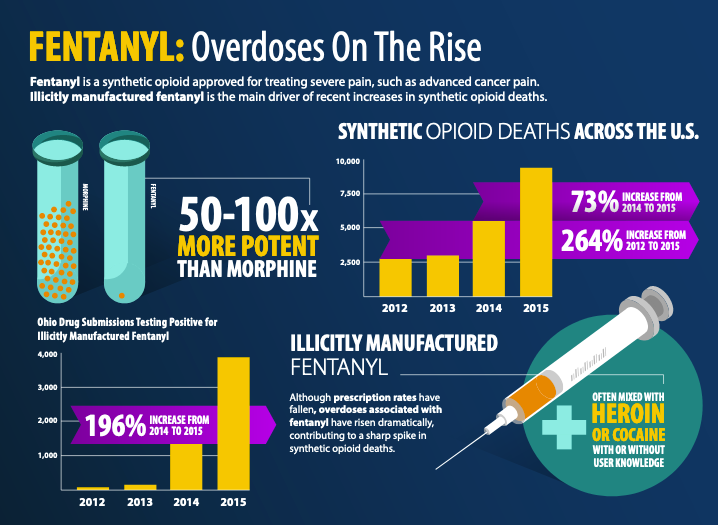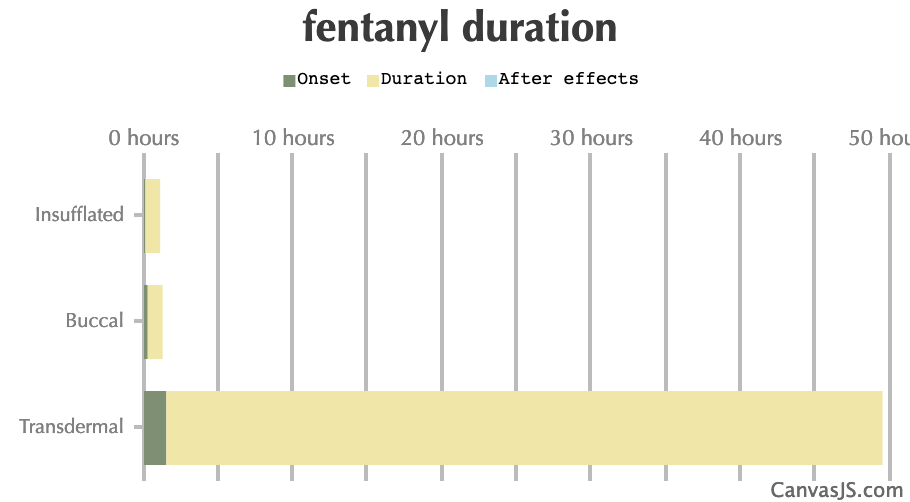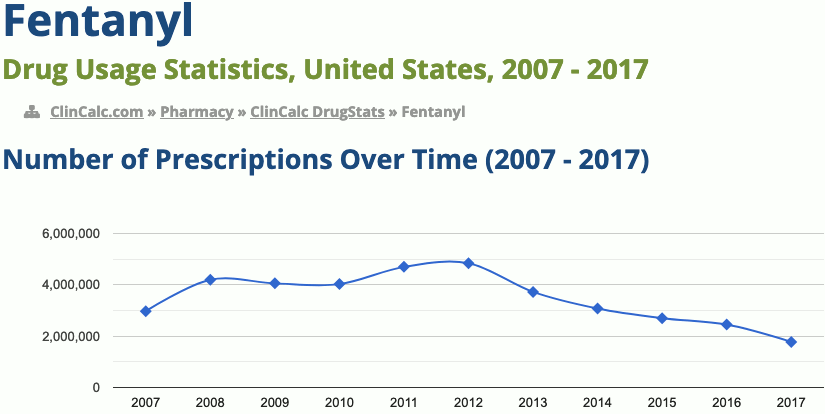[ Home ] [ Controlled Substances ] [ Opioids ]
FENTANYL
|

Fentanyl
About Fentanyl:
- Fentanyl is a strong opioid painkiller. It's used to treat severe pain, for example during or after an operation or a serious injury, or pain from cancer.
- It is also used for other types of pain that you've had for a long time when weaker painkillers have stopped working.
- Fentanyl is available only on prescription. It comes as:
- Patches to be put on your skin
- Lozenges and tablets that dissolve in the mouth
- Nasal spray
- Injections (usually only given in hospital)
- Fentanyl patches are used for long-lasting pain. Your doctor may also prescribe other types of fentanyl if you need extra pain relief while your regular painkiller wears off.
Key Facts:
- Fentanyl works by blocking pain signals from travelling along the nerves to the brain.
- The most common side effects of fentanyl are constipation, and feeling sick and sleepy.
- It is possible to become addicted to fentanyl, but this is rare if you are taking it to relieve pain and your doctor is reviewing your treatment regularly.
- It's best not to drink alcohol when you first start taking (or using) fentanyl. You're more likely to get side effects such as feeling sleepy or drowsy.
- Tell a doctor or nurse about your fentanyl patch if you're having any treatment or tests. Also, remind your pharmacist about your patch when you collect prescriptions or buy other medicines.
How much will I take?
- Fentanyl can be used by most adults.
- Some patches can be used in children from the age of 2 years and over. However, young children and older people are more likely to get side effects.
- Fentanyl tablets, lozenges, nasal spray and injections are fast-acting. They're used for pain that is expected to last for a short time.
- Fentanyl patches are slow-release. This means fentanyl is gradually released through the skin into your body.
Fentanyl patches are usually only used if you've been taking other strong opioid painkillers.
Strength of fentanyl
- A fentanyl injection into a vein gives the quickest pain relief. It works almost straight away and is usually only given in hospital.
- Tablets - 100 micrograms to 800 micrograms
- Lozenges - 200 micrograms to 1,600 micrograms
- Nasal spray - 50 micrograms to 400 micrograms
- Fast-acting fentanyl tablets, lozenges and nasal sprays take around 15 to 30 minutes to work but they wear off after 4 to 6 hours.
- Patches - these release 12 micrograms to 100 micrograms of fentanyl every hour
- Fentanyl patches can take up to a day or two to start working but they will last longer. Patches are usually given after fentanyl tablets. This is to make sure that you have pain relief from the tablets until the patches start to work.
Do not apply more than 1 patch at a time. Using more than 1 patch could cause a fatal overdose.
Fentanyl is a potent agonist of mu opioid receptor. It is used to relieve severe pain, such as after surgery or during cancer treatment, and breakthrough pain (flare-ups of intense pain despite round-the-clock narcotic treatment). Fentanyl is an extremely powerful analgesic, 50 - 100-times more potent than morphine. Fentanyl harbors massive risk for addiction and abuse regardless of its prescription form. Fentanyl abuse is especially dangerous to those without a tolerance to opioids. The substance's already elevated risk of overdose is multiplied when someone without a tolerance abuses it.
 Fentanyl:
Fentanyl:
https://drugs.ncats.io/drug/UF599785JZ
Pharmaceutical fentanyl is a synthetic opioid pain reliever, approved for treating severe pain, typically advanced cancer pain. It is prescribed in the form of transdermal patches or lozenges and can be diverted for misuse and abuse in the United States. However, most recent cases of fentany related harm, overdose, and death in the U.S. are linked to illegally made fentanyl. It is sold through illegal drug markets for its heroin-like effect. It is often mixed with heroin and/or cocaine as a combination product - with or without the user's knowledge - to increase its euphoric effects.

https://www.cdc.gov/drugoverdose/opioids/fentanyl.html

Fentanyl is a powerful synthetic opioid analgesic that is similar to morphine but is 50 to 100 times more potent. It is typically used to treat patients with severe pain or to manage pain after surgery. It is also sometimes used to treat patients with chronic pain who are physically tolerant to other opioids.
Non-pharmaceutical fentanyl is sold in the following forms: as a powder; spiked on blotter paper; mixed with or substituted for heroin; or as tablets that mimic other, less potent opioids.
Fentanyl works by binding to the body's opioid receptors, which are found in areas of the brain that control pain and emotions. Its effects include euphoria, drowsiness, nausea, confusion, constipation, sedation, tolerance, addiction, respiratory depression and arrest, unconsciousness, coma, and death. The high potency of fentanyl greatly increases risk of overdose, especially if a person who uses drugs is unaware that a powder or pill contains fentanyl
Why is fentanyl dangerous?
Opioid receptors are also found in the areas of the brain that control breathing rate. High doses of opioids, especially potent opioids such as fentanyl, can cause breathing to stop completely, which can lead to death. The high potency of fentanyl greatly increases risk of overdose, especially if a person who uses drugs is unaware that a powder or pill contains fentanyl. Fentanyl sold on the street can be mixed with heroin or cocaine, which markedly amplifies its potency and potential dangers.
Lethal Dose of Fentanyl (2 milligrams)

Pharmaceutical fentanyl was developed for pain management treatment of cancer patients, applied in a patch on the skin. Because of its powerful opioid properties, Fentanyl is also diverted for abuse. Fentanyl is added to heroin to increase its potency, or be disguised as highly potent heroin. Many users believe that they are purchasing heroin and actually don't know that they are purchasing fentanyl - which often results in overdose deaths. Clandestinely-produced fentanyl is primarily manufactured in Mexico.
- Fentanyl is a potent synthetic opioid drug approved by the Food and Drug Administration for use as an analgesic (pain relief) and anesthetic.
- approximately 100 times more potent than heroin as an analgesic.
- Fentanyl was first developed in 1959 and introduced in the 1960s as an intravenous anesthetic.
- entanyl, similar to other commonly used opioid analgesics(e.g., morphine), produces effects such as relaxation, euphoria, pain relief, sedation, confusion, drowsiness, dizziness, nausea, vomiting, urinary retention, pupillary constriction, and respiratory depression.
- Abuse of Fentanyl can be injected, snorted/sniffed, smoked, taken orally by pill or tablet, and spiked onto blotter paper.
- The presence of triad of symptoms such as coma, pinpoint pupils, and respiratory depression are strongly suggestive of opioid poisoning
- Overdose may result in stupor, changes in pupillary size, cold and clammy skin, cyanosis, coma, and respiratory failure leading to death.
- Drugs that cause similar effects include other opioids such as morphine, hydrocodone, oxycodone, hydromorphone, methadone, and heroin.

https://www.dea.gov/factsheets/fentanyl
Fentanyl is now considered the number one drug leading to opioid overdose deaths in America.
Overview:
- 1959-1960: First developed
- Fentanyl is a legal prescription drug used for pain control during surgery and for chronic or breakthrough cancer pain.
- It's also manufactured illegally and sold for its euphoric effects.
- Street drugs like heroin, cocaine and methamphetamine are being laced with this opioid, as are counterfeit drugs made to look like the real ones, like Vicodin or Xanax.
- Fentanyl works in the brain to block pain and is in the same class of drugs as morphine or hydrocodone but is about 50 to 100 times more potent.
- Just 2 to 3 milligrams of this drug can kill a person. It blocks opioid receptors and its most dangerous side effect - like other opioids - is respiratory depression, which can quickly lead to coma and death.
- Users may not realize the street drug they are buying from a dealer contains this potentially lethal compound.
- it is now considered the number one opioid killer due to overdose deaths as reported by the U.S. Centers for Disease and Control (CDC) in 2018.
- Duragesic, the patch, can be fatal because high amounts of the drug are retained in the patch after use. The patch can fall off and lead to an overdose if touched.
- Fentanyl can be injected, snorted, smoked, taking it orally, spiked onto blotter paper which is then put in the mouth
- People who abuse this opioid do it for the pleasurable effect. When opioid drugs bind to opioid receptors, they boost dopamine levels in the brain's reward areas, causing a state of euphoria or a "high", with relaxation, calm and drowsiness.
- Like other opioids, the use of this drug, whether legal or illegal, is highly addictive.
- When fentanyl is being abused the magnitude of the effects are often unpredictable because the amount of drug taken is usually unknown.
- Fentanyl analogs are illegal drugs that are chemically related and designed to mimic its opiate-like effects.
- Fentanyl is an extremely potent, fully synthetic (man-made) opioid.
- Fentanyl is so potent that law officers and first responders are warned to wear protective clothing during known raids to prevent inhalation or skin absorption of the drug.
- Prince, an iconic American singer, songwriter and musician died in 2016 at the age of 57 due to an accidental fentanyl overdose.
- Many people who overdose begin with a legitimate injury or simply do not understand the potency and deadly nature of these medications.
Interactions:
Drug Interactions (539) Alcohol/Food Interactions (1) Disease Interactions (18)
What other drugs will affect Fentanyl?
Dangerous drug interactions with fentanyl can occur. Drugs such as other pain medicines, anti-depressant medicines, sleeping pills, anti-anxiety medicines, antihistamines, or tranquilizers may interact and have serious or life-threatening effects. Always tell any doctor you see that you use this drug and have a drug interaction screen before taking any medicine with fentanyl.A total of 539 drugs are known to interact with Fentanyl.
- 239 major drug interactions
- 297 moderate drug interactions
- 3 minor drug interactions
 Excerpt from Drugs.com:
Excerpt from Drugs.com:
https://www.drugs.com/illicit/fentanyl.html
| Maximum Dosage: | |
|---|---|
| Prescribers Digital Reference | |

Duragesic (fentanyl) - Drug Summary: https://www.pdr.net/drug-summary/Duragesic-fentanyl-268.1033 | |
| Adults: | 4 doses/day of Actiq, Fentora, or Onsolis transmucosal; 800 mcg/dose, 2 doses/break-thru pain episode, and 4 treated episodes/day of Abstral sublingual; 1600 mcg/dose, 2 doses/break-thru pain episode, and 4 treated episodes/day of Subsys sublingual; 800 mcg/dose and 4 doses/day of Lazanda nasal spray; 40 mcg/dose and 80 doses/day with Ionsys; with appropriate dosage titration, there is no maximum dose of other dosage forms. |
| Geriatric: | 4 doses/day of Actiq, Fentora, or Onsolis transmucosal; 800 mcg/dose, 2 doses/break-through pain episode, and 4 treated episodes/day of Abstral sublingual; 1600 mcg/dose, 2 doses/break-thru pain episode, and 4 treated episodes/day of Subsys sublingual; 800 mcg/dose and 4 doses/day of Lazanda nasal spray; 40 mcg/dose and 80 doses/day with Ionsys; with appropriate dosage titration, there is no maximum dose of other dosage forms. |
| Adolescents: | 16 to 17 years: 4 units/day of fentanyl transmucosal lozenge (i.e., Actiq). With appropriate dosage titration, there is no maximum dose of transdermal or intravenous fentanyl. The safety and efficacy of other dosage forms have not been established. |
| Adolescents: | 13 to 15 years: With appropriate dosage titration, there is no maximum dose of transdermal or intravenous fentanyl. The safety and efficacy of other dosage forms have not been established. |
| Children: | 2 to 12 years: With appropriate dosage titration, there is no maximum dose of transdermal or intravenous fentanyl. The safety and efficacy of other dosage forms have not been established. |
| Children: | 1 year: With appropriate dosage titration, there is no maximum dose of intravenous fentanyl The safety and efficacy of other dosage forms have not been established. |
| Infants: | With appropriate dosage titration, there is no maximum dose of intravenous fentanyl. The safety and efficacy of other dosage forms have not been established. |
| Neonates: | With appropriate dosage titration, there is no maximum dose of intravenous fentanyl. The safety and efficacy of other dosage forms have not been established. |
| Duration: Fentanyl is approximately 100 times more potent than Morphine, and is commonly used as a patch. Sometimes used as an adulterant for heroin, which has led to many overdose deaths. NOTE: Due to Fentanyl's high potency, it is incredibly difficult to measure safely, and so can easily lead to overdose. | |||
| Route | Onset | Duration | After Effects |
|---|---|---|---|
| Tripsit Factsheets | |||

Fentanyl Basic Information: http://drugs.tripsit.me/fentanyl | |||
| Insufflated: | 5-15 minutes | 1-4 hours | Risk |
| Buccal: | 15-30 minutes | 1-4 hours | Risk |
| Transdermal: | 90-180 minutes | 48-72 hours | Risk |

| |||
| Effects: Analgesia, euphoria, feelings of relaxation, sedative effects, changes in focus, attention, respiratory depression, nausea, constipation, dry mouth, somnolence, confusion, weakness, sweating, fatigue, dizziness, anxiety | |||
| Warning: Risk of post-acute withdrawal effects, including depression, anxiety disorder, psychosis, suicidal ideation in extreme cases. | |||
| Side Effects: |
| Get emergency medical help if you have signs of an allergic reaction: hives; chest pain, difficult breathing; swelling of your face, lips, tongue, or throat. |
|---|
| RxList |

Duragesic (fentanyl transdermal): https://www.rxlist.com/duragesic-drug/patient-images-side-effects.htm |
| Opioid medicine can slow or stop your breathing, and death may occur. A person caring for you should seek emergency medical attention if you have slow breathing with long pauses, blue colored lips, or if you are hard to wake up. |
Remove the skin patch and call your doctor at once if you have:
|
| Seek medical attention right away if you have symptoms of serotonin syndrome, such as: agitation, hallucinations, fever, sweating, shivering, fast heart rate, muscle stiffness, twitching, loss of coordination, nausea, vomiting, or diarrhea. |
| Serious side effects may be more likely in older adults and those who are overweight, malnourished, or debilitated. |
Common side effects may include:
|
| This is not a complete list of side effects and others may occur. Call your doctor for medical advice about side effects. You may report side effects to FDA at 1-800-FDA-1088. |
| Black Box Warnings: |
|---|

Sublimaze (fentanyl) (Rx): https://reference.medscape.com/drug/sublimaze-fentanyl-343311 |
|
Risk of opioid addiction, abuse, and misuse, which can lead to overdose and death; assess each patient's risk prior to prescribing and monitor all patients regularly for the development of these behaviors or conditions Life-threatening respiratory depression
Accidental ingestion
Neonatal opioid withdrawal syndrome
Risks from concomitant use with benzodiazepines or other CNS depressants
|
Pediatric:
Appropriate studies have not been performed on the relationship of age to the effects of fentanyl injection in children younger than 2 years of age.Safety and efficacy have not been established.
Geriatric:
Appropriate studies performed to date have not demonstrated geriatric-specific problems that would limit the usefulness of fentanyl injection in the elderly. However, elderly patients are more likely to have age-related lung, kidney, liver, or heart problems, which may require caution and an adjustment in the dose for patients receiving fentanyl injection.Other Interactions:
- Ethanol
- Grapefruit Juice
Other Medical Problems:
Make sure you tell your doctor if you have any other medical problems, especially:
- Adrenal problems
- Brain tumor, history of
- Breathing or lung problems (eg, COPD, respiratory depression, sleep apnea)
- Cor pulmonale (serious heart condition)
- Drug dependence, especially with narcotics, or history of
- Head injury, history of
- Heart disease
- Hypokalemia (low potassium levels in the blood)
- Hypomagnesemia (low magnesium levels in the blood) - Use with caution. May increase risk for more serious side effects
- Bradycardia (slow heart rhythm)
- Gallbladder problems
- Heart rhythm problems (eg, QT prolongation)
- Hypertension (high blood pressure)
- Hypotension (low blood pressure)
- Pancreatitis (inflammation or swelling of the pancreas)
- Seizures, history of - Use with caution. May make these conditions worse
- Kidney disease
- Liver disease - Use with caution. The effects may be increased because of slower removal of the medicine from the body
 Fentanyl (Injection Route) (Sublimaze):
Fentanyl (Injection Route) (Sublimaze):
https://www.mayoclinic.org/drugs-supplements/fentanyl-injection-route/description/drg-20075614
Breastfeeding:Summary of Use During Lactation:
When used epidurally or intravenously during labor or for a short time immediately postpartum, amounts of fentanyl ingested by the neonate are usually small and are not expected to cause any adverse effects in breastfed infants.The results of studies on the effect of epidural fentanyl on breastfeeding initiation and duration are mixed and controversial, because of the many different combinations of drugs, dosages and patient populations studied as well as the variety of techniques used and deficient designs of many of the studies.
In infants placed skin-to-skin after a normal vaginal delivery, epidural fentanyl given during labor may delay the infant's first suckling in a dose-dependent manner, perhaps because it can persist in the infant's serum for over 24 hours after discontinuation. However, it appears that with good breastfeeding support, epidural fentanyl plus bupivacaine has little overall effect on breastfeeding success.No waiting period or discarding of milk is required before resuming breastfeeding after fentanyl is used for short procedures (e.g., for endoscopy). After general anesthesia, breastfeeding can be resumed as soon as the mother has recovered sufficiently from anesthesia to nurse. When a combination of anesthetic agents is used for a procedure, follow the recommendations for the most problematic medication used during the procedure.
Limited information indicates that transdermal fentanyl in a dosage of 100 mcg/hour results in undetectable fentanyl concentrations in breastmilk.
Newborn infants seem to be particularly sensitive to the effects of even small dosages of narcotic analgesics. Once the mother's milk comes in, it is best to provide pain control with a nonnarcotic analgesic and limit maternal intake of fentanyl to a few days at a low dosage with close infant monitoring.If the baby shows signs of increased sleepiness (more than usual), difficulty breastfeeding, breathing difficulties, or limpness, a physician should be contacted immediately.
Effects on Lactation and Breastmilk:
Fentanyl can increase serum prolactin. However, the prolactin level in a mother with established lactation may not affect her ability to breastfeed.Alternate Drugs to Consider:
- Acetaminophen
- Butorphanol
- Hydromorphone
- Ibuprofen
- Morphine
 Fentanyl Drug Levels and Effects:
Fentanyl Drug Levels and Effects:
https://www.ncbi.nlm.nih.gov/books/NBK501222/
Liver:
Alfentanil, remifentanil, and sufentanil are phenylpiperidine analogues of fentanyl and have a similar spectrum of activity, but differ in their pharmacokinetics, potency and routes of administration, and are used only in anesthesia. None of the phenylpiperidine opioids have been implicated in causing serum enzyme elevations or clinically apparent liver injury.
Fentanyl Hepatotoxicity:
Although fentanyl has many serious side effects and has been implicated in deaths from overdose and inadvertent use, it has not been linked to cases of clinically apparent liver injury. In large clinical trials, chronic fentanyl therapy for pain has not been associated with serum enzyme elevations or cases of hepatotoxicity. The dangers of fentanyl are largely from respiratory depression rather than liver injury. Fentanyl and its analogues are metabolized in the liver largely by the P450 enzyme system, and plasma levels are affected by inhibitors (yielding higher levels and increasing toxicity) and inducers (yielding lower levels and reduced efficacy) of CYP 3A4.E Likelihood score: E (all four are unlikely cases of clinically apparent liver injury).
 Fentanyl Overview:
Fentanyl Overview:
https://www.ncbi.nlm.nih.gov/books/NBK548026/

250th most prescribed medicine in the United States for 2017

https://clincalc.com/DrugStats/Drugs/Fentanyl
Duragesic = Fentanyl Patch
Actiq = Lozenge lollipop
Abstral = Tablet for under the tongue
Fentora = Tablet for between the cheek and gum
Lazandra = Nasal Spray
Onsolis = Film
Subsys = Spray for under the tongue
Street fentanyl is either as a powder or in tablets
Apache, China Girl, China Town, China White, Dance Fever, Friend, Goodfellas, Great Bear, He-Man, Jackpot, King Ivory, Murder 8, Poison, Tango & Cash.
SOME OF THE FENTANYL ANALOGS:
![]()
- ACETYL-ALPHA-METHYLFENTANYL
- ACETYLFENTANYL
- ACRYLFENTANYL
- ACTIQ
- ALPHA-METHYLFENTANYL
- ANPP
- BETA-HYDROXYFENTANYL
- BETA-HYDROXYTHIOFENTANYL
- BUTYRYLFENTANYL
- CHINAWHITE
- CYCLOPENTYLFENTANYL
- CYCLOPROPYLFENTANYL
- DURAGESIC
- FLUOROISOBUTYRYLFENTANYL
- FURANYLFENTANYL
- INNOVAR
- ISOBUTYRYLFENTANYL
- METHOXYACETYLFENTANYL
- ORALET
- ORTHO-FLUOROFENTANYL
- PARA-CHLOROISOBUTYRYLFENTANYL
- PARA-FLUOROBUTYRYLFENTANYL
- PARA-FLUOROFENTANYL
- PARA-FLUOROISOBUTYRYLFENTANYL
- PARA-METHOXYBUTYRYLFENTANYL
- SUBLIMAZE
- TETRAHYDROFURANYL
- THIOFENTANYL
- VALERYLFENTANYL


https://www.cdc.gov/nchs/data/nvsr/nvsr68/nvsr68_03-508.pdf


https://www.whitehouse.gov/sites/whitehouse.gov/files/images/Final%20STANDARD%20size%20of%20Fentanyl%20Safety%20Recommendations%20for%20First%20Respond....pdf

https://www.canada.ca/en/health-canada/services/substance-use/controlled-illegal-drugs/fentanyl/exposure.html

https://www.fentanylsafety.com/about-fentanyl/


http://www.drugpolicy.org/sites/default/files/Synthetic-Opioids-Fact-Sheet.pdf


https://d14rmgtrwzf5a.cloudfront.net/sites/default/files/drugfacts-fentanyl.pdf


https://www.ismp.org/sites/default/files/attachments/2018-11/fentanyl1-13.pdf


https://www.epa.gov/sites/production/files/2018-07/documents/fentanyl_fact_sheet_ver_7-26-18.pdf

https://adf.org.au/wp-content/uploads/2018/12/Fentanyl-Fact-Sheet-FINAL.pdf

https://erowid.org/experiences/subs/exp_Pharms_Fentanyl.shtml
Fentanyl has a rapid onset and effects generally last less than two hours. It is the most widely used synthetic opioid in medicine. The patches for cancer pain are on the WHO List of Essential Medicines (the most effective and safe medicines). Illicit use of pharmaceutical fentanyl and its analogues first appeared in the mid-1970s. As of 2018 fentanyl was the most commonly listed opioid in overdose drug deaths surpassing heroin. Some heroin dealers mix fentanyl powder with heroin to increase potency or compensate for low-quality heroin.
Metro Atlanta drug bust leads to $1 million in fentanyl, hand grenade, cash; 10 arrested - Officials estimate the drugs taken off the streets had a street value well over $1 million and said the amount of fentanyl seized was enough to kill nearly 4.1 million people. Thursday January 01, 2026 - msn.com In one year, Trump pivots fentanyl response from public health to drug war - Experts say Biden's focus on addiction health care saved tens of thousands of lives and slowed fentanyl smuggling. Trump scrapped Biden's approach in favor of military strikes. 11,000 fentanyl pills seized in 5-month North Carolina drug sting - The incident began in July and continued with "numerous" controlled buys of fentanyl from a man in the Princeville area. Ten arrested after metro Atlanta drug raids; GBI seizes fentanyl, guns and a grenade - The operation targeted street-level drug distribution in Paulding, Cobb, Haralson, Carroll and Douglas counties ... Trump Designates Fentanyl an Official 'Weapon of Mass Destruction' — Says Drug Causes More Damage Than Any Bomb - President Donald Trump on Monday said he was signing an executive order that officially designated fentanyl as a weapon of mass destruction, saying the drug is more potent and damaging than any bomb. Trump designates street fentanyl as a WMD, escalating militarization of the drug war - Trump already declared the drug cartels terrorist organizations and ordered military strikes against suspected drug boats. Now he's declaring fentanyl a weapon of mass destruction. Experts are ... Officers seize 67,000 fentanyl pills, other drugs in Adams County; 2 men face felony charges - Two men face multiple felony drug charges following searches of Adams County apartments and the seizure of what authorities said were an estimated 67,000 fentanyl pills, 521 grams of ... What does designating fentanyl as weapon of mass destruction mean for war on drugs? - The move by the Trump administration to designate fentanyl as a weapon of mass destruction could mark a significant step in the U.S. military’s campaign against drug trafficking. Agents discover fentanyl stash in I-5 search, latest in series of San Diego Sector drug seizures - Agents from the San Clemente Station on Tuesday conducted a vehicle stop on northbound Interstate 5, the Border Patrol said in a news release. A search under the front seats uncovered seven packages ... Drug enforcement detectives save infant who ingested fentanyl - During the incident the child’s mother drove away from the apartment complex and was later involved in a crash. PBSO: Fentanyl seized in drug bust could have killed hundreds of thousands - Masri said the Florida Department of Law Enforcement and the U.S. Drug Enforcement Administration gave PBSO $120,000 in overtime expenses and an additional $90,000 for undercover drug buys. He ... An Anchorage fentanyl activist told the president the drug should be classified as a WMD. Now it is. - Sandy Snodgrass was at the White House this month for the signing of fentanyl education legislation named after her son Bruce, who died from the drug in an Anchorage parking lot.
| ||
| Opioids | Link to this page |









